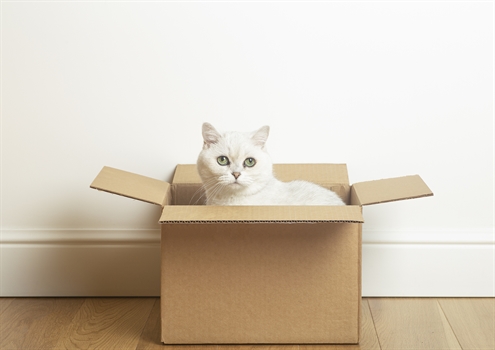Moving home can be a stressful time for everyone in your household, pets included. So how do you make a house move easier on your cat? There are a lot of changes to take in, and your cat will not appreciate being taken out of their routine and away from their comfort zone. Cats are territorial, and are more likely to stray from a new home if they are stressed. To make the transition easier on both of you, there are a few things you can do.
Prepare your cat in advance for a house move
Start by introducing your cat to the idea of moving. If they’ve never ridden a car before or used a cat carrier, practice before moving day. Let them get used to the cat carrier in a low-stress situation by leaving it open somewhere in your home. Use toys and treats to encourage your cat to go inside.
You could also take your cat for a short ride in the car to familiarise them with the sound and motion.
Talk to your vet if you need further advice. For example, they may be able to recommend a calming pheromone spray or plug-in for cats. They can also give advice on what and when to feed your cat before travel to avoid your cat feeling sick. Vets For Pets has advice on traveling with a cat.
Check your new home is cat safe
If possible, view your new home before moving day to check it is cat safe. Check fences are secure; look out for garden flowers that are toxic to cats, such as lilies; and be aware of busy main roads.
You may also want to give your new home a thorough clean, particularly if the previous owners had cats themselves. Focus particularly on cat-height areas, as these are likely to be marked with the other cats’ scents, which might be confusing and upsetting for your cat.
Provide your cat with a safe and comfortable place to hide.
Your cat may feel overwhelmed by the changes going on as you pack up your old home. Gradually move their bed and toys into a space that you can keep calm and quiet in the run-up to the move. Put your cat in this room the night before you move so that they are not missing when the time comes to leave. Keep them in there until you are ready to depart, and ask your helpers to keep the door closed.
A cat is likely to be disorientated by new surroundings, too, so it's important to provide them with a safe place to hide in your new home. As soon as you arrive, unpack their things into a quiet spot, perhaps with a hidey-hole like a box or a cupboard, where they can rest and recover from the journey. Offer food, water and a litter tray to encourage your cat to make themselves at home.
Keep your cat's routine as consistent as possible.
Cats thrive on routine. So try to keep your cat's feeding and sleeping schedule the same as it was before the move. This will help them feel more secure and less stressed.
Pack their things at the last minute – this will mean you can find them quickly at your destination, too.
Blankets and cushions that smell of your cat, and of you, may be comforting to your cat during a house move.
Be patient and understanding when moving house with a cat
Moving is stressful for people and cats. Be patient and understanding with your cat, and give them time to adjust to their new surroundings. If your cat is used to lots of one-to-one time, make time for them during your house move. It will calm you down as much as it does them! And look after yourself, for example by choosing a really good removals firm.
Using self-storage to make your move easier
If you're moving into a smaller home or apartment, you may not have enough space to bring all of your belongings with you. Self-storage is a great way to store the things you don't need right away, such as furniture, appliances, and seasonal items. Reputable storage companies will require you to insure your stored goods as part of your contract with them. Your storage company may add insurance to your bill – but you can get your self-storage insurance from another provider like Store and Insure. Get a quick quote to see if we can save you money on your self-storage insurance. You may be wondering, do self-storage units have insurance? Yes, most self-storage units have to be insured. However, it's important to read the fine print to make sure you understand what is and is not covered.
Moving home with a pet cat can be a challenge, but it doesn't have to be. By following these tips, you can make the transition easier for both you and your furry friend.





